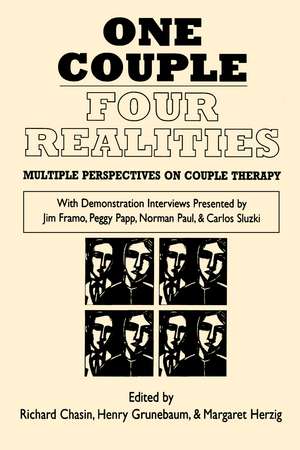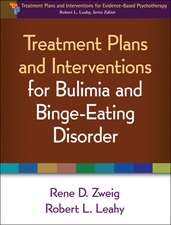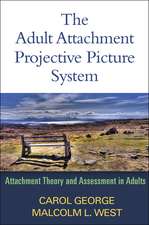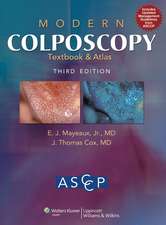One Couple, Four Realities: Multiple Perspectives on Couple Therapy
Editat de Richard Chasin, Henry Grunebaum, Margaret Herzigen Limba Engleză Paperback – 22 apr 1992
An outgrowth of an Harvard Medical School Couple Therapy Conference, this is the first book on couple and family therapy to combine a range of clinical theories with a single case discussion. At the conference, Jim Framo, Peggy Papp, Norman Paul, and Carlos Sluzki--therapists well-known for their differing styles and theoretical persuasions--described and explained the sessions they each conducted with the same couple. These sessions varied greatly: each has a distinctive focus; two included family of origin members; one involved a co-therapist. Later, other therapists, representing an even broader range of perspectives, discussed their viewpoints and speculated how they might have approached the same case.
In ONE COUPLE, FOUR REALITIES: MULTIPLE PERSPECTIVES ON COUPLE THERAPY, the experience of attending this conference is recreated and expanded. The reader is first given the same background information about the couple that was supplied to the interviewers and is then presented with edited transcripts and commentary by Framo, Papp, Paul, and Sluzki about their own sessions. Further perspectives and approaches to the case are provided by a number of other teachers of therapy. Thus, the reader is invited to view the couple from over a dozen different perspectives, including psychodynamic, object relations, systemic, behavioral, feminist, contextual, and eclectic orientations.
Perhaps the most fascinating perspective is provided by the couple, Larry'' and Jennifer,'' who, in the last section of the book, detail their reactions to the four demonstration sessions. Their stunningly candid and intelligent accounts, given soon after the original interviews, and then again six years later, provide a compelling conclusion to the book.
Most published cases are selected retrospectively to illustrate the power of the author's approach. By contrast, this couple was selected in advance: their case, ongoing at the time in a Boston clinic, seemed suitable for the demonstration interviews to be videotaped for the Harvard conference. The couple was bright and engaging. They and their families of origin were willing to participate. The interviewers agreed to document the sessions no matter how they turned out. This prospective method of case selection lent authenticity to the interviews, permitting the viewers, and now the reader, to witness clinical work as it might unfold in the office of any therapist.
This volume is not intended to and does not demonstrate the superiority of one approach over another. Each of the four demonstration interviews represents careful, conscientious work, and each leads to a different ``reality'' about the couple. Only in a volume such as this can one see in high relief what each approach brings to light and what each obscures.
All therapists interested in couples should find this book useful, as it stimulates readers to scrutinize their own theories and practices, consider how they might have approached Larry and Jennifer, and ponder what their own viewpoint may have caused them to overlook. Clinicians will appreciate the theoretical discussions and case analyses. The book is a natural supplemental text for courses in couple or family therapy. Teachers may learn much from the appendix which addresses ethical and therapeutic aspects of using videotaped demonstration interviews--important issues that have been neglected in the professional literature. The book may also have personal resonance for non-professionals interested in exploring the complexity of one couple's relationship. All will find ONE COUPLE, FOUR REALITIES accessible and thought-provoking. Through the lives of Larry'' and Jennifer,'' it addresses timeless and timely questions about the personal, familial, and cultural forces that create, shape, and strain the bonds that hold couples together.
In ONE COUPLE, FOUR REALITIES: MULTIPLE PERSPECTIVES ON COUPLE THERAPY, the experience of attending this conference is recreated and expanded. The reader is first given the same background information about the couple that was supplied to the interviewers and is then presented with edited transcripts and commentary by Framo, Papp, Paul, and Sluzki about their own sessions. Further perspectives and approaches to the case are provided by a number of other teachers of therapy. Thus, the reader is invited to view the couple from over a dozen different perspectives, including psychodynamic, object relations, systemic, behavioral, feminist, contextual, and eclectic orientations.
Perhaps the most fascinating perspective is provided by the couple, Larry'' and Jennifer,'' who, in the last section of the book, detail their reactions to the four demonstration sessions. Their stunningly candid and intelligent accounts, given soon after the original interviews, and then again six years later, provide a compelling conclusion to the book.
Most published cases are selected retrospectively to illustrate the power of the author's approach. By contrast, this couple was selected in advance: their case, ongoing at the time in a Boston clinic, seemed suitable for the demonstration interviews to be videotaped for the Harvard conference. The couple was bright and engaging. They and their families of origin were willing to participate. The interviewers agreed to document the sessions no matter how they turned out. This prospective method of case selection lent authenticity to the interviews, permitting the viewers, and now the reader, to witness clinical work as it might unfold in the office of any therapist.
This volume is not intended to and does not demonstrate the superiority of one approach over another. Each of the four demonstration interviews represents careful, conscientious work, and each leads to a different ``reality'' about the couple. Only in a volume such as this can one see in high relief what each approach brings to light and what each obscures.
All therapists interested in couples should find this book useful, as it stimulates readers to scrutinize their own theories and practices, consider how they might have approached Larry and Jennifer, and ponder what their own viewpoint may have caused them to overlook. Clinicians will appreciate the theoretical discussions and case analyses. The book is a natural supplemental text for courses in couple or family therapy. Teachers may learn much from the appendix which addresses ethical and therapeutic aspects of using videotaped demonstration interviews--important issues that have been neglected in the professional literature. The book may also have personal resonance for non-professionals interested in exploring the complexity of one couple's relationship. All will find ONE COUPLE, FOUR REALITIES accessible and thought-provoking. Through the lives of Larry'' and Jennifer,'' it addresses timeless and timely questions about the personal, familial, and cultural forces that create, shape, and strain the bonds that hold couples together.
Preț: 341.91 lei
Preț vechi: 359.91 lei
-5% Nou
Puncte Express: 513
Preț estimativ în valută:
65.45€ • 71.11$ • 55.01£
65.45€ • 71.11$ • 55.01£
Carte tipărită la comandă
Livrare economică 21 aprilie-05 mai
Preluare comenzi: 021 569.72.76
Specificații
ISBN-13: 9780898620290
ISBN-10: 0898620295
Pagini: 420
Ilustrații: illustrations
Dimensiuni: 156 x 234 x 20 mm
Greutate: 0.59 kg
Ediția:Revised
Editura: Guilford Publications
Colecția Guilford Press
ISBN-10: 0898620295
Pagini: 420
Ilustrații: illustrations
Dimensiuni: 156 x 234 x 20 mm
Greutate: 0.59 kg
Ediția:Revised
Editura: Guilford Publications
Colecția Guilford Press
Public țintă
Professional Practice & DevelopmentRecenzii
By far! The best available demonstration of the multiple perspectives of couples therapy. --Phil Striegel, The University of Iowa, Iowa City
I've used the book several times for a course in Marital Therapy (I taught the same course two times). What I like about it is that it gives a breadth of different schools of therapy. While looking at the same case, the authors give their comments on the process at the same time. I also really appreciate the ethical concerns raised by this book, even to the point of the authors saying they might not do it again. This type of self critical, self reflexive perspective is very beneficial. My students have found it to be very useful and very understandable, particularly the chapter on contextual therapy. --Jerry Gale, Ph.D., University of Georgia
The book's strength is being able to communicate similarities and differences between different theoretical models in conceptualizing behavior. It shows different interpretations of the same basic concepts which helps students understand theories better. The book is extremely well written and I found it to be very useful on the graduate school level. --Margaret Crosbie-Burnett, Ph.D., University of Miami
Now, from that intellectual summit of couples' treatment--the annual Harvard Couple Therapy Conference--has come this remarkable Rashomon-like narrative. One Couple, Four Realities is a bit of a clinical thriller: sophisticated, ever and ever more revealing, and thoroughly absorbing throughout.'' --Maggie Scarf, author of Intimate Partners
Startling and dramatic! These were my reactions to reading these reports by four therapists who consulted with the same couple. This volume makes vividly and undeniably clear how radically different these therapists are. In addition, comments by a number of other therapists document starkly differing perspectives about the same clinical material. Further, the comments of the clients themselves immediately after the consultations, and again after 6 months and 6 years, convey distinctive perceptions and sobering, surprising, afterthoughts about the meaning of these consultations for them and their families of origin. Finally the editors conclude with badly needed, thought-provoking reflections on the ethics of using demonstration interviews and tapes for the teaching of therapy. This volume should and will stimulate challenging debate not only among therapists, but also among training program directors, and, all who participate in demonstration interviews, including the couples and families themselves.'' --Lyman C. Wynne, M.D., Ph.D., author of Systems Consultation
Here is surely a book for the constructivist age! A fascinating study of multiple perspectives....Most provocative and intriguing is the couple's own feedback on the experience at three points in their later lives....This book is unique for the multiplicity of perspectives provided on the same family across points of view and through time. It will make you rethink your own caseload....'' --Monica McGoldrick, M.S.W., author of Ethnicity and Family Therapy
I've used this book several times for a course in Marital Therapy. What I like about it is that it gives a breadth of different schools of therapy. While looking at the same case, the authors give their comments on the process at the same time. I also really appreciate the ethical concerns raised by this book....This type of self critical, self reflexive perspective is very beneficial. My students have found it to be very useful and very understandable, particularly the chapter on contextual therapy. --Jerry Gale, Ph.D., University of Georgia
The book's strength is being able to communicate similarities and differences between different theoretical models in conceptualizing behavior. It shows different interpretations of the same basic concepts which helps students understand theories better. The book is extremely well written and I found it to be very useful on the graduate school level. --Margaret Crosbie-Burnett, University of Miami
-I've used the book several times for a course in Marital Therapy (I taught the same course two times). What I like about it is that it gives a breadth of different schools of therapy. While looking at the same case, the authors give their comments on the process at the same time. I also really appreciate the ethical concerns raised by this book, even to the point of the authors saying they might not do it again. This type of self critical, self reflexive perspective is very beneficial. My students have found it to be very useful and very understandable, particularly the chapter on contextual therapy. --Jerry Gale, Ph.D., University of Georgia
The book's strength is being able to communicate similarities and differences between different theoretical models in conceptualizing behavior. It shows different interpretations of the same basic concepts which helps students understand theories better. The book is extremely well written and I found it to be very useful on the graduate school level. --Margaret Crosbie-Burnett, Ph.D., University of Miami
Now, from that intellectual summit of couples' treatment--the annual Harvard Couple Therapy Conference--has come this remarkable Rashomon-like narrative. One Couple, Four Realities is a bit of a clinical thriller: sophisticated, ever and ever more revealing, and thoroughly absorbing throughout.'' --Maggie Scarf, author of Intimate Partners
Startling and dramatic! These were my reactions to reading these reports by four therapists who consulted with the same couple. This volume makes vividly and undeniably clear how radically different these therapists are. In addition, comments by a number of other therapists document starkly differing perspectives about the same clinical material. Further, the comments of the clients themselves immediately after the consultations, and again after 6 months and 6 years, convey distinctive perceptions and sobering, surprising, afterthoughts about the meaning of these consultations for them and their families of origin. Finally the editors conclude with badly needed, thought-provoking reflections on the ethics of using demonstration interviews and tapes for the teaching of therapy. This volume should and will stimulate challenging debate not only among therapists, but also among training program directors, and, all who participate in demonstration interviews, including the couples and families themselves.'' --Lyman C. Wynne, M.D., Ph.D., author of Systems Consultation
Here is surely a book for the constructivist age! A fascinating study of multiple perspectives....Most provocative and intriguing is the couple's own feedback on the experience at three points in their later lives....This book is unique for the multiplicity of perspectives provided on the same family across points of view and through time. It will make you rethink your own caseload....'' --Monica McGoldrick, M.S.W., author of Ethnicity and Family Therapy
I've used this book several times for a course in Marital Therapy. What I like about it is that it gives a breadth of different schools of therapy. While looking at the same case, the authors give their comments on the process at the same time. I also really appreciate the ethical concerns raised by this book....This type of self critical, self reflexive perspective is very beneficial. My students have found it to be very useful and very understandable, particularly the chapter on contextual therapy. --Jerry Gale, Ph.D., University of Georgia
The book's strength is being able to communicate similarities and differences between different theoretical models in conceptualizing behavior. It shows different interpretations of the same basic concepts which helps students understand theories better. The book is extremely well written and I found it to be very useful on the graduate school level. --Margaret Crosbie-Burnett, University of Miami
Stimulating...would clearly enhance any advanced course on marital and family therapy from a practice, research, or training perspective.
--Contemporary Psychology, 3/3/1992Notă biografică
Richard Chasin, Henry Grunebaum, Margaret Herzig














